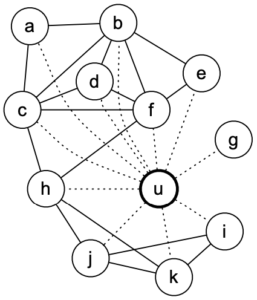And before you ask– No, it’s not because Zuckerburg reads through all your online conversations.
In 2013, a Cornell University alumni Lars Backstrom (who has worked at Facebook since 2009, helped create the “People You May Know” feature, and is currently the VP of Engineering) and professor Jon Kleinberg published a paper titled: “Romantic Partnerships and the Dispersion of Social Ties: A Network Analysis of Relationship Status on Facebook”. The paper discloses several algorithms developed to identify romantic relationships between users on Facebook. The duo attempted to first solve the problem of identifying a user’s partner given that the user has set their relationship status to “in a relationship”, “engaged” or “married”. The paper later attempts to solve related problems, such as identifying whether a user is in a romantic relationship. For the purposes of this blog post, I will delve into the first question.
Before reading the paper, one might anticipate that the partner is probably the person with the highest level of embeddedness with the individual. From personal experience, most relationships are born within already-established friend groups, where the embeddedness between a couple is high given all the mutual friends shared between them. However, the paper reveals that finding partners through embeddedness only is correct less than a quarter of the time.
The paper instead introduces a different measure to identify a structure within links, called dispersion. The dispersion of two people A and B is essentially how many people B knows from A’s social network, such that the people that B knows do not know each other. The paper provides an eloquent analogy to describe dispersion: “Consider, for example, a husband who knows several of his wife’s co-workers, family members, and former classmates, even though these people belong to different foci and do not know each other” (Backstrom & Kleinberg, 2013, page 3).

Figure 1. A graph taken from the paper (page 3). In this graph, the dispersion between (h, u) is the highest compared to any other edge (h, x), x being any other node.
The algorithm developed to solve this problem evolves throughout the paper to eventually reach an astounding accuracy of 70.5%. First, a simple variable was created, called normalized dispersion, which is the dispersion divided by the embeddedness of an edge. It was found that the accuracy of finding the partner by finding the link with the maximum normalized dispersion value improves from under 25% (using just embeddedness) to 48%. Eventually, the algorithm evolves to use recursive dispersion, which is looking at the dispersion between the entire social network of the person instead of just the dispersion of a single edge. Recursive dispersion was shown to be an effective measure, with the paper disclosing that “on the subset corresponding to married male Facebook users in the United States, the friend with the highest recursive dispersion is the user’s spouse 76.9% of the time” (Backstrom & Kleinberg, 2013, page 5). Combining recursive dispersion with interaction analysis, such as investigating “the number of messages sent between two people, the number of photos in which u and v are jointly tagged, the number of times that u has ‘liked’ v’s content and vice versa” (Backstrom & Kleinberg, 2013, page 7), etc…, the final algorithm achieves its largest accuracy of 70.5%. If you are interested in learning more on how the algorithm was developed or learning more about dispersion, and how similar problems were solved, I highly recommend reading the original text– it is very easy to read and extremely interesting as well!
Everyone knows the saying “Tell me who your friends are, and I will tell you who you are”. Personally, I find it mind-boggling, and possibly slightly depressing even, to think that just my social network can characterize so much of who I am. But I also believe that the volatility of a social network should inspire; Because of how your social network inevitably evolves over your lifetime, you are not who you were ten years ago, and you will definitely not be the same in ten years time.
So, if you want to change yourself, self-love and juice cleanses can only go so far. The real answer is simply to meet more people (or sometimes… cut some off) and make new friends. Because the more your social network grows and experiences change, the more you will change along with it.
Resources
Backstrom, L., & Kleinberg, J. (2013). Romantic Partnerships and the Dispersion of Social Ties: A Network Analysis of Relationship Status on Facebook. https://doi.org/10.1145/2531602.2531642
Jon Kleinberg. Jon Kleinberg’s Homepage. (n.d.). Retrieved October 13, 2022, from https://www.cs.cornell.edu/home/kleinber/
Lars Backstrom – VP Engineering – facebook | linkedin. (n.d.). Retrieved October 13, 2022, from https://www.linkedin.com/in/lars-backstrom-862a764
Steele, B. (2014, February 13). Facebook graph reveals who you love. Phys.org. Retrieved October 13, 2022, from https://phys.org/news/2014-02-facebook-graph-reveals.html